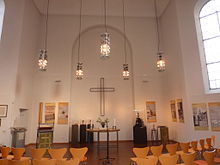Friedenskirche (Cologne-Mülheim)
The Friedenskirche in today's Cologne-Mülheim is the oldest Protestant church building in today's Cologne .
History of the community
In 1610, the Lutherans and Calvinists in the Duchy of Jülich-Berg were given the privilege of building a church in Mülheim and appointing pastors during the Jülich-Klevian succession dispute. The year 1610 is considered to be the founding year of the Evangelical Church Community Mülheim am Rhein.
One of the regents, Margrave Ernst , gave both faiths a common cemetery property in 1612 . The first Lutheran church stood on the wall on today's Kirchturmstrasse. The Reformed bought a simple preaching house on the Rhine. In 1615 the Cologne fortress and city of Mülheim burned down, with the churches also being lost. Only after the end of the Thirty Years War in 1648 could parish life revive. The church, rebuilt in 1665 at the old location, then fell victim to the ice drift of the Rhine in February 1784 . Until a new building was planned, the services could be held in the Reformed Church on Taubenstrasse / Formesstrasse.
In 1837 the previously independent communities were ordered by the Prussian King Friedrich Wilhelm III. united into one within the Church of the Old Prussian Union . Since only one church was needed now, the smaller church hall was sold and called the church of peace due to the peaceful union.
Church building
Just two years after the destruction, the new church at today's Wallstrasse 70-72, a little further from the Rhine, was inaugurated in 1786. Its builder was Willhelm Hellwig. From 1845 to 1848 the cruciform church, crowned with a lantern , was fitted with a tower designed by the Cologne cathedral builder Ernst Friedrich Zwirner . The three high neo-Romanesque sound windows on each side under the tower end are striking .
During the Second World War , the district was largely destroyed as a result of air raids. In particular, the impacts of October 28, 1944 also affected the church. After the community center and the neighboring Luther Church had been rebuilt as an emergency church, the Church of Peace, rebuilt by the architects Carl and Karl-Heinz Klag, was consecrated again in 1960. The previously double-curved spire with a lantern in between had to be dispensed with; today it ends with a flat Romanesque pyramid. The interior of the church was redesigned in 1998/99.
Organs in the Friedenskirche
The Friedenskirche from 1786 already received a large organ on the altar side in 1791 , which was built by the organ builder Christian Kleine. The instrument had 32 registers ; the pulpit was integrated in the organ case. Correspondence between Kleine and another organ builder from the Hunsrück has survived on this organ building. The action also tells us that when the key was pressed lightly, only the positive sounded, and when the key was pressed completely, the rest of the organ sounded. This enabled the congregation to be clearly guided in choral singing. The organ was destroyed in the Second World War.
In 1965 the organ builder Willi Peter from Cologne built a neo-baroque work with 17 registers, which was set up on the newly built west gallery. The organ had a mechanical action made of plastic and metal and electrical stops. The instrument was shut down and sold in 2016 due to deficiencies in the electrics and action. The organ builder Gerald Woehl won the tender for a new organ .
By the Reformation anniversary in 2017 , the most important part of the organ was completed in a first construction phase. Like the work of Willi Peter, the new organ was built on the west gallery. The prospectus was designed based on the first organ from 1791.
The new instrument is a symphonic work with 37 registers (approx. 1,800 pipes ), including several transmissions and extended registers.
The organ has slide chests , the music mechanisms and the coupling are mechanical. Some rows of pipes used as transmissions are electrically operated, as are the stops. There is a typesetting system with a total of approx. 1000 storage spaces.
On Reformation Day 2018, the organ was completely finished and inaugurated in a series of concerts by well-known organists. It is intended to continue to hold organ concerts in the Friedenskirche.
Disposition of the Woehl organ
|
|
|
||||||||||||||||||||||||||||||||||||||||||||||||||||||||||||||||||||||||||||||||||||||||||||||||||||||||||||||||||||||||||||||||||||
-
Pairing :
- Normal coupling: II / I, I / P, II / P
- Sub-octave coupling: I / I, II / I, II / II, I / P, II / P
- Super octave coupling: I / I, II / I, II / II, I / P, II / P
- Playing aids : crescendo roller, wind throttle, "classic wind" (imitation of historical wind supply)
Individual evidence
- ↑ Information about the organ on the website of the parish (as of August 16, 2018)
- ^ Community letter "Die Brücke", issues 1 and 2/2017 .
Web links
Coordinates: 50 ° 57 ′ 50 ″ N , 7 ° 0 ′ 5 ″ E

